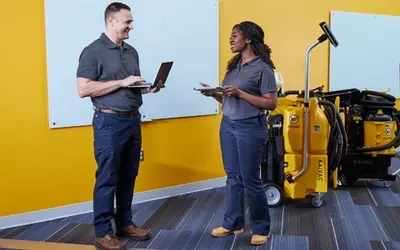3 Questions to Ask Before Starting a Cleaning and Disinfecting Program

A professional cleaner’s job is to keep a facility and its occupants healthy. An effective cleaning and disinfecting program helps accomplish that. However, we need to clean and disinfect sensibly.
As we analyze the steps taken by the professional cleaning industry to address the pandemic, one of the issues coming to light is the overuse of disinfectants. Known as indiscriminate disinfecting, disinfectants were used just about anywhere and everywhere. This can be harmful to the cleaner, building users, and the environment.
Answer the following questions to create a sensible cleaning and disinfecting program:
1. What Cleaning and Disinfecting Tools Are Available?
For the most part, you can clean using almost any professional-grade cleaning solution. And when it comes to disinfecting, we also have a wide variety of options.
Methods of Disinfection:
- Electrostatic sprayers and foggers
- Ultraviolet (UV-C) light systems
- Hydrogen peroxide, isopropyl alcohol, and hypochlorous acid – all considered safer disinfecting alternatives
- EPA-registered disinfectants, including N-List disinfectants
- Natural disinfectants (often made from plant-based materials and primarily used in residential cleaning)
2. Do We Need to Use Disinfectants?
This is an excellent question which you should ask before developing a cleaning and disinfecting program. The Centers for Disease Control and Prevention (CDC) states in most cases, “cleaning with an effective detergent is all that is needed to […] maintain a healthy facility.” This is because proper cleaning removes most soils and contaminants from a surface. You should only use disinfectants when needed to eliminate (kill) any remaining contaminants or pathogens on a surface.
3. How Do We Determine if Disinfectants Are Necessary?
To determine this requires a cleaning and disinfecting audit. For example, when building owners are looking for ways to reduce water consumption, one of the first things they do is conduct a water audit. They tour the facility, looking for the following:
- Where they are using water
- Where water-saving fixtures or devices could be installed
- Unnecessary water usage
- Evident leaks
While there are no average savings, most building owners and managers report considerable reductions in water consumption after an audit.
In the same way, we can reduce the number of disinfectants used by conducting a cleaning and disinfecting audit. This is key to a sensible cleaning and disinfecting program and involves a walk-through looking for these three types of areas:
High-Touch or High-Risk Areas
Building users touch these areas frequently throughout the day, likely causing contamination. Office kitchens and restrooms are perfect examples, as are commonly used conference rooms. Cleaning and disinfecting are necessary for these areas. In fact, you may even need to clean them several times per day.
Low-Touch/Low-Risk Areas
You will not need to clean these areas as often and you may not need to be disinfect them at all. For example, storage and mechanical rooms may not need disinfecting.
Moderate Touch/Moderate Use Areas
These areas typically pose negligible health risks to building users. This could include rarely used conference or meeting rooms or classrooms. In commercial cleaning, you usually clean these areas before/after use or as needed but you seldom disinfect them.
Implementing a Sensible Cleaning and Disinfecting Program
With our disinfecting audit completed, we can now implement a sensible cleaning and disinfecting program that minimizes the overuse of disinfectants. This will improve the health of a building. Moreover, it will increase worker productivity. If crews do not need to clean or disinfect certain areas, they can devote more time to those areas that do require more frequent cleaning and disinfecting.
Cleaning and Disinfecting and High-Flow Fluid Extraction
Finally, a sensible cleaning and disinfecting program help crews determine what cleaning tools and equipment to use. For instance, Kaivac recommends using their N-List disinfectant KaiBosh when cleaning and disinfecting with Kaivac cleaning systems.
High-Flow Fluid Extraction (HFFE), which is the basis of all Kaivac No-Touch Cleaning® systems, can effectively remove contaminants and pathogens without disinfectants. Cleaning with HFFE helps ensure surfaces stay cleaner, healthier, and safer for building users—which is genuinely sensible cleaning and disinfecting.
Related Posts

Beyond the Restroom: Kaivac for Fast, Easy, and Complete Kitchen Floor Care
You already know and trust Kaivac for restroom care. Our No-Touch Cleaning® systems make the unpleasant task of servicing restrooms fast, easy and complete. But did you know Kaivac has cleaning machines for every kind of floor?
Read more
Cleaning Verification Made Easy with KaiNect
The KaiNect™ app from Kaivac gives you visibility into your entire cleaning operation right in the palm of your hand. Here’s how the KaiNect app helps you manage your teams, troubleshoot small issues, prevent big problems, and verify cleaning companywide.
Read more
Top Five Cleaning Challenges Facility Managers Face—And How to Solve Them Fast
Today’s facility professionals face tons of facility cleaning challenges. Surprisingly (or not surprisingly), these janitorial pain points remain pretty consistent over the years. Here’s the top five cleaning challenges facility managers face and how tools from Kaivac can solve them.
Read more